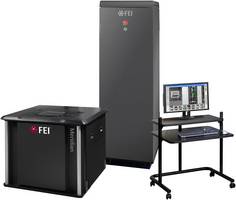nProber III and Meridian 7 EFA Tools offer fault localization upto 7 and 10 nm.
Press Release Summary:

Providing solution for fault isolation, electrical probing, delayering, sample preparation and imaging, atomic-level imaging in a transmission electron microscope (TEM), nProbe III enables FA engineers to extract thin samples for fault analysis in TEM. Offering certainty in CAD and navigation, Meridian 7 optical fault isolation tool provide less cross talk and higher waveform signal-to-noise.
Original Press Release:
New Electrical Failure Analysis Workflow Solutions for Advanced IC Devices at ISTFA
New easy-to-use nanoprobe and optical fault isolation tools provide fault localization and transistor characterization down to the most advanced 7nm technology node
Semiconductor manufacturers can turn to new electrical failure analysis (FA) solutions for the tools required to identify and analyze faults in their products. The new nProber III fault localization and transistor characterization tool developed by FEI provides process development and failure analysis down to the 7nm technology node. The new Meridian 7 optical fault isolation tool, also developed by FEI, is designed to provide the resolution needed for non-destructive localization of electrical faults at sub-10nm nodes. These solutions will be presented this week at ISTFA, November 6-10, 2016 in Fort Worth, Texas, FEI Booth # 106.
“Automation is a high priority in our roadmap,” said Cecelia Campochiaro, vice president, electrical failure analysis (EFA) solutions, Thermo Fisher Scientific. “The nProber III system begins our move toward automating the nanoprobing technique by incorporating intelligent-guided operations designed to improve time-to-results and reduce the skill required to run the tool.”
These new solutions are part of a complete EFA workflow which includes: fault isolation, electrical probing, delayering, sample preparation and imaging, and when needed, atomic-level imaging in a transmission electron microscope (TEM). The nProber III allows FA engineers to find and characterize individual devices preparatory to extracting thin sectional samples for physical failure analysis in TEM. In some critical applications, nanoprobing can potentially increase TEM success rates. Designed to be effective and easy-to-use tool, the nProber III doubles the resolution and probe stability over its predecessor.
The new Meridian 7 provides visible laser voltage imaging and probing and dynamic laser stimulation on sub-10nm devices. By avoiding a requirement for ultra-thin substrates, it preserves the integrity and functionality of the device under test to provide a reliable and practical production solution. It offers a 25 percent optical resolution enhancement over the previous-generation system and has a smaller spot size for better fault localization. In addition, the new Meridian 7 offers more certainty in navigation and computer-aided design (CAD) overlay, less cross-talk and higher waveform signal-to-noise over its predecessor.
Please visit ISTFA 2016 (FEI booth 106) to learn more about these products and the EFA workflow, or visit: http://bit.ly/2fLQZvH.
About Thermo Fisher Scientific
Thermo Fisher Scientific Inc. is the world leader in serving science, with revenues of $17 billion and more than 50,000 employees in 50 countries. Our mission is to enable our customers to make the world healthier, cleaner and safer. We help our customers accelerate life sciences research, solve complex analytical challenges, improve patient diagnostics and increase laboratory productivity. Through our premier brands – Thermo Scientific, Applied Biosystems, Invitrogen, Fisher Scientific and Unity Lab Services – we offer an unmatched combination of innovative technologies, purchasing convenience and comprehensive support. For more information, please visit www.thermofisher.com
Media Contact Information:
Marcia Goff
Thermo Fisher Scientific
+1 781-622-1248




